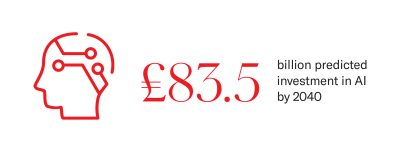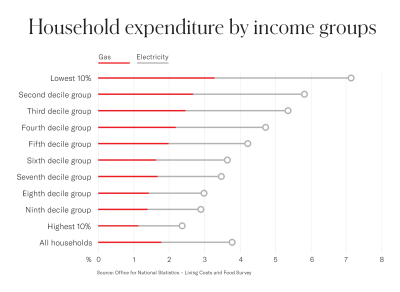The management of energy consumption is at the centre of current debates. The rise in energy prices and overall cost of living is putting many people at risk of financial hardship and forcing governments to take action against the climate crisis.
Ofgem, the UK energy regulator, has warned of potential gas shortages this winter and raised the energy price cap by 80%, starting October 2022. Traditional energy infrastructures are failing due to environmental factors and geopolitical uncertainty. Last winter, an increase in extreme weather events left several areas in the United Kingdom and other parts of the world without electricity on several occasions, and it is likely to happen again in the future.

Interestingly, an answer to these emerging issues lies in technology. According to research, artificial intelligence (AI) is set to transform the energy sector in the coming years, allowing companies to accelerate the move to renewables and harness the variable nature of energy sources. With a predicted investment of £83.5 billion by 2040, AI technologies have been called ‘the new electricity’ for their potential to radically change the way many industries operate.
Smart devices and AI-power models can be used to monitor and predict energy demand. Crucially, they can also analyse energy consumption patterns and produce accurate bills, so users do not pay for more than they use. This insight explores five ways in which AI can revolutionise the energy sector.

1. Identifying faults to prevent energy outages
Infrastructure and equipment failure is one of the most common concerns in the energy sector. Recent research estimates that downtime costs the sector around $50 billion globally every year. In a landscape that is increasingly reliant on energy sources for vital daily activities, the ability to spot possible failures before they happen is essential. AI can do exactly that.
Smart scheduling of maintenance can improve long-term infrastructure performance, significantly reducing repair costs. This can be achieved through computer vision solutions, AI-based technologies that allow computers to observe infrastructures such as energy plants or gas pipes. By analysing visual data, computers can predict and identify failures quickly and, in some cases, replace manual inspections.
For example, in 2019, Schneider Electric was one of the first companies to use Microsoft’s automated machine learning and predictive analytics solution to determine which remote equipment might need repairs. This way, oil and gas producers were able to save on maintenance costs, optimise revenue and increase safety for workers and the environment.
2. Smart grids and microgrids
AI can be integrated with energy grids, creating smart grids. Smart grids allow energy companies to collect data from every customer on the grid to monitor energy usage. Thanks to real-time sensors and data analytics tools, companies can create energy efficiency projects for customers, such as preventing waste during peak hours, and ensuring energy goes where it is needed.
Similarly, microgrids use AI to manage and optimise energy usage. Microgrids can function separately from a traditional grid, so they can prove lifesaving in emergency situations. As our planet faces increasingly extreme weather and natural disasters, microgrids can facilitate the integration of renewables into traditional systems.
3. Maximising renewable energy use with virtual power plants
Much like microgrids, virtual power plants (VPPs) are gaining popularity in the transition to net zero. A VPP is a network of decentralised power units that are operated and monitored from a single control system. The units can be anything from power producers and consumers to power storage units.
While traditional grids have a limited storage capacity, which can lead to imbalances and outages, VPPs have variable capacity. If managed correctly, VPPs can reach the same capacity as several nuclear power plants. This also means that VPPs can better manage the fluctuation in renewable energy, providing power from various sources as and when needed.
This flexibility is not only good for the planet, but for markets too. VPPs use a secure data connection to transmit commands and data between the single power units and the control system. Real-time exchange of data means that VPPs can quickly balance the grid, instantly reacting to changes in energy prices.
4. Reducing poverty and environmental impact with smart devices
Smart meters and solar panels have become common in UK households, delivering real-time meter readings. This technology allows consumers to pay for the energy they are actually using while helping monitor consumption levels. Both things are vital for the planet and protect vulnerable groups from falling into poverty.
A 2019 report by Microsoft and PwC estimated that using AI-powered technology in the energy sector could help reduce global emissions by up to 4% by 2030. Practices and policies designed to reduce global warming are also central to tackling social inequality.
According to the Office for National Statistics, household services, including utilities, were the largest contributor to the inflation rate of 4.8% between December 2019 and December 2021. The same report highlights that fuel poverty in the UK is at its highest since the first ONS report in 2006. This is because spending on gas and electricity is higher for the poorest households: in the 2020 financial year, they spent 54% of their weekly budget on bills, compared to 42% in the richest households.

The most vulnerable population in the UK is disproportionately affected by the energy crisis, including single mothers, disabled people and elderly people. The Covid-19 pandemic caused further financial insecurity, with people falling in rent arrears. A survey by the National Residential Landlord Association at the end of 2020 found that 800,000 renters were in arrears and 18% of them accumulated over £1000 in unpaid rent. This is a factor that keeps the most vulnerable groups unable to sustain energy costs.
In order to help up to 100,000 people struggling with fuel bills, UK Power Networks (UKPN), in partnership with Energy System Catapult, launched the Social Connect project. Social Connect AI and data science techniques to collect data from fuel poverty insights, individual household smart meters, and geographical socio-economic statistics. This data is then combined into a single dashboard to offer an overview of affected areas. In this case, AI could prove vital where people are less likely to ask for support, with potentially lifesaving outcomes.
Additionally, the UK government launched a new Energy Company Obligation (ECO4) scheme. The scheme, worth £4 billion, aims to deliver energy efficiency and heating measures to homes in Great Britain. ECO4 supports low-income households, including those who do not receive benefits. It is estimated that the scheme will help at least 3.5 million eligible households.
5. Using analytics to predict demand and increase production
Predictive analytics are key to managing energy consumption and optimising production according to real demand. Machine learning (ML) and artificial intelligence are being used to understand consumers’ energy usage. Specifically, ML applied to smart meters and sensors can support energy efficiency in homes by detecting occupancy patterns.
This could also be applied, for example, in an elderly person’s home. When the system detects unusual activity patterns, such as lights or appliances not being switched on for an unusually long time, it can send alerts to a designated carer. According to a recent paper by TechUK, many companies in the UK have already started to develop these technologies.
Additionally, predictive analytics and algorithms allow energy companies to plan for infrastructure management in times of uncertainty like the winter. The Met Office has recently increased its use of predictive AI technologies for weather forecasting, which enables increased efficiency in operational decisions. For example, this means energy companies would be able to increase or reduce the number of on-call engineers depending on weather conditions, increasing operational efficiency.

“By offering alternatives to paper processes, digital technology allows organisations in the energy sector to drastically increase productivity without compromising on customer service. Whether it's managing clients, or distributing contracts, ROCK is familiar with recurring challenges in this industry and how technology can provide solutions. ROCK has delivered a number of successful digital transformation projects for leading organisations within energy and utilities. This includes Artificial Intelligence which is having a positive impact on energy companies and their customers.” – Terry Crichan, Enterprise Account Manager at ROCK.
Conclusion: the importance of artificial intelligence in the energy sector
As the world transitions to renewable energy, artificial intelligence will become increasingly important in the energy sector. This insight explored AI solutions that are currently emerging, such as smart grids and VPPs, which can improve the efficiency and reliability of energy sources. However, the adoption of AI in the energy sector is often slow and there is room for growth.
It is imperative that energy companies implement AI technology to support customers through the current cost of living crisis, as instances of wrong billing can lead people into poverty. With tools such as smart meters and solar panels, we can help the planet and improve people’s lives.
Sources
- Department for Digital, Culture, Media and Sport (2022) AI activity in UK businesses: Executive Summary. UK Government 12 January 2022. [Accessed: 7 October 2022]
- Glover, B. and Jeyabraba, M. (2022) The bottom line: an investigation of rent arrears in social housing. British Library 7 February 2022. [Accessed: 7 October 2022]
- Israel, A. (2021) How AI will transform the energy sector. Sifted 5 October 2021. [Accessed: 6 October 2022]
- Lawson, A. (2022) Ofgem rises energy price cap by 80% to £3,549 from October. The Guardian 26 August 2022. [Accessed: 7 October 2022]
- Office for National Statistics (2022) Energy Prices and their effect on households. ONS 1 February 2022. [Accessed: 7 October 2022]
- Microsoft (2019) Schneider Electric minimises costs and worker risk with Azure Machine Learning service predictive maintenance. Microsoft 2 May 2019 [Accessed: 6 October 2022]
- Rolnick, D. et al. (2019) Tackling climate change with Machine Learning. Arxiv 19(6). [Accessed: 7 October 2022]
- TechUK (2021) AI for energy: opportunities for applying AI in the energy sector. Tech UK May 2021. [Accessed: 6 October 2022]
- UK Power Networks (2021) Social connect. [Accessed: 6 October 2022]